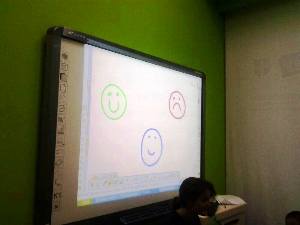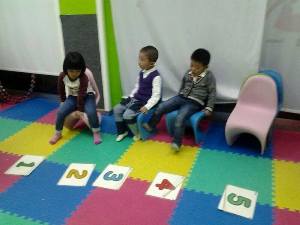Small Stars
 Phonics at EF is generally taught in Small Star and High Flyer classes, where young children are learning to read in English for the first time and ‘decoding’ the written language. While I’ve done some phonics activities in my HF class, most of my experience so far with phonics has come in Small Star Life Clubs. It can be difficult, even frustrating, trying to teach really young children how to learn to read in a foreign language, but with patience and routines the results can be rewarding once you start to notice their progress. I begin my Small Star Life clubs the same way I would a normal class: review of the rules, have the students introduce themselves to each other, and then go through a brief warm up routine, usually something along the lines of ‘head and shoulders knees and toes.’ Once the children are settled, the teacher can begin with step 1 of teaching phonics.
Phonics at EF is generally taught in Small Star and High Flyer classes, where young children are learning to read in English for the first time and ‘decoding’ the written language. While I’ve done some phonics activities in my HF class, most of my experience so far with phonics has come in Small Star Life Clubs. It can be difficult, even frustrating, trying to teach really young children how to learn to read in a foreign language, but with patience and routines the results can be rewarding once you start to notice their progress. I begin my Small Star Life clubs the same way I would a normal class: review of the rules, have the students introduce themselves to each other, and then go through a brief warm up routine, usually something along the lines of ‘head and shoulders knees and toes.’ Once the children are settled, the teacher can begin with step 1 of teaching phonics.
Identification and Isolation
 The first step to teaching phonics is identification. Students learn to recognize the letter symbol and the sound that it represents. This can be done through pictures on the IWB and flashcard games. The next step is isolation, where the sound, say /s/, the first phoneme taught, is isolated from all other sounds and pronounced on its own. I like to write a part of the alphabet on the board, leaving the ‘letter of the day’ blank for the kids to fill in. The next step will be to draw pictures, such as a snake or a sun on the board with the word next to it, again leaving the first letter blank so the kids can fill it in, as you elicit the proper sound. You can practice the sound by ‘passing it’ in a circle, then you want to make sure that they can hear the sound, and how it might sound different next to a different phoneme that sounds similar, and run a minimal pairs activity where they run between a ‘yes’ hoop if they hear the sound and a ‘no’ hoop if they don’t. Once they know the sound and can recognize it, you can move on to blending and segmenting.
The first step to teaching phonics is identification. Students learn to recognize the letter symbol and the sound that it represents. This can be done through pictures on the IWB and flashcard games. The next step is isolation, where the sound, say /s/, the first phoneme taught, is isolated from all other sounds and pronounced on its own. I like to write a part of the alphabet on the board, leaving the ‘letter of the day’ blank for the kids to fill in. The next step will be to draw pictures, such as a snake or a sun on the board with the word next to it, again leaving the first letter blank so the kids can fill it in, as you elicit the proper sound. You can practice the sound by ‘passing it’ in a circle, then you want to make sure that they can hear the sound, and how it might sound different next to a different phoneme that sounds similar, and run a minimal pairs activity where they run between a ‘yes’ hoop if they hear the sound and a ‘no’ hoop if they don’t. Once they know the sound and can recognize it, you can move on to blending and segmenting.
Blending and Segmenting
 The next activities I run in a phonics class are where I place, ‘blend’ the phoneme next to other phonemes in order to practice saying simple words. I usually run hopscotch activities with flashcards in order to get the students saying each individual sound. If the sound is /s/, then I will place, for example, the sounds /s/ /a/ /t/ on the floor. I say the word ‘sat’ so the children can jump over each flashcard saying each individual sound. The next part of the activity would be for the teacher to say each sound and have the students say the final word. I will also place a hoop at the end of the hopscotch and have the students say the final word after saying each individual sound within the word. Different types of activities can be run using this methodology. Students really enjoy an element of competition in activities, so games where they can compete, such as a race or ‘who can say it louder’ work really well too.
The next activities I run in a phonics class are where I place, ‘blend’ the phoneme next to other phonemes in order to practice saying simple words. I usually run hopscotch activities with flashcards in order to get the students saying each individual sound. If the sound is /s/, then I will place, for example, the sounds /s/ /a/ /t/ on the floor. I say the word ‘sat’ so the children can jump over each flashcard saying each individual sound. The next part of the activity would be for the teacher to say each sound and have the students say the final word. I will also place a hoop at the end of the hopscotch and have the students say the final word after saying each individual sound within the word. Different types of activities can be run using this methodology. Students really enjoy an element of competition in activities, so games where they can compete, such as a race or ‘who can say it louder’ work really well too.
Writing
For the majority of the class, students practice saying the phoneme, first on its own, then blended together with other phonemes. They practice looking at each letter, saying the appropriate sound correctly, until they can form words with different individual sounds. The final part of the class is where they practice writing, first tracing the letter in its upper and lower case form, then within greater words. As the lessons continue, students will eventually develop all the skills needed to read and write in English effectively.

















Thank you for sharing these practical steps of teaching phonics. I am going to teach my younger students phonics for the first time and I don’t have any ideas of what sound I should introduce the students first. How do you decide which sounds you go first?
Hi Wayan!
There is, believe it or not, a proper order in which to teach the sounds. Jolly Phonics is the program that my EF school used. You will see that the first three sounds to teach are s/a/t. You can read more about it using this link.
http://jollylearning.co.uk/overview-about-jolly-phonics/
Hope this helps and good luck in your phonics class!
Hey Gillian Campbell thanks you so much for sharing such a informative article. Even I am teaching phonics to my students and even they are getting fast. but I this your tips can give us a boost to learn and understand quickly.
Hi Wayan
Im teaching jolly phonics to my Kindergarteners from last 3 years, always remember to introduce each sound with a story and a song
Hi! I have been an esl teacher for 10 years (2 years to adult) and am probably going to start teaching jolly phonics soon. I’m trying to do some research now but I am struggling with the concept for teaching 2-6 year olds as it seems to be based on reading and writing. In my experience very few of this age group can read in their own language or write. How do you introduce the sounds via stories when the students have no vocabulary so wont understabd the story! I am trying to see the benefits of jolly phonics but am struggling. Any advice appreciated!